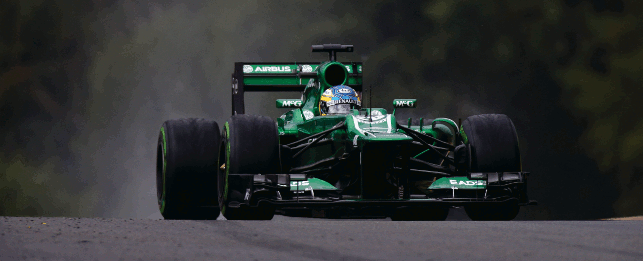The 2014 Formula One racing season will bring with it some of the biggest changes to Formula One racing’s design processes.

The Caterham F1 racecar on the track earlier in the 2013 season
The new 1.6-litre turbocharged V6 engines will take the headlines, but the rules concerning aerodynamics and energy saving are to be transformed.
These massive changes will see a range of variations in how the cars will look and perform, meaning the perceived smaller teams from this season might well be fighting for podium finishes next year.
Wind tunnel testing, which traditionally demands expensive testing facilities, was once restricted to the bigger teams. But thanks to powerful Computational Fluid Dynamics (CFD) software this can now be done in the virtual space, opening it up to a new breed of digitally-focussed smaller teams on the grid.
Preparing its team for the regulation changes in 2014, Caterham F1 has partnered with Dell to provide the hardware and servicing knowledge to power its challenge for the 2014 season.
Where wind tunnel results are restricted by costs, and lack of variation, computer simulation has endless possible scenarios.
Computing cluster
At the heart of Caterham F1’s base is the Dell Intel Xeon-based high performance computing (HPC) cluster (see box piece).
Bathed in blue light within its cooled chamber, it’s all based on industry standard products – so should anything fail, a part can be sourced almost immediately.
Time is of the essence: the HPC cluster runs 24 hours a day, seven days a week, 365 days a year with a constant queue of jobs. It typically has about six ‘jobs’ going through it at any one time, which could each last anywhere from six hours to two days.
The team can run digital cars over an infinitely wide ‘wind-tunnel’; in traffic, following each other, overtaking – giving them all sorts of simulation variables that couldn’t be done in a physical wind tunnel.
Plus it costs much less than anything previously, there’s no build time for physical prototypes, man-hours, calibration, or material costs.
The design office might come up with 100 different ideas of how something might work. Those ideas are put through the CFD software to narrow it down to a top five.
The final designs are then built in the model shop and are tested in the wind tunnel as well. A final choice is then fitted to a test car equipped with masses of sensors and driven at full speed in straight lines.
Data from all three types of testing are then compared against each other to find the optimum design to be fitted to the final racecar on the grid.
With the motorsport governing body, FIA, regulations, like wind tunnel test time, limiting the compute power per team, the future of F1 design looks likely to rely on the power of the server more than the engine.
Caterham’s Dell HPC cluster
The system consists of 186 Dell PowerEdge M610 blade servers with Intel Xeon processors.
These are housed in energy-efficient Dell PowerEdge M1000e modular blade enclosures and connected to Dell PowerVault MD3200 and MD1200 storage arrays.
Dell PowerConnect 6xxx/7xxx/8xxx series switches also manage the HPC environment’s data traffic.
Dell enters technology partnership with Caterham F1
Default






